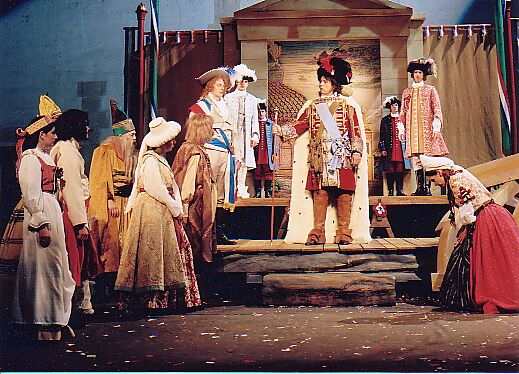This production is first a clear labour of love for the founder of this series, its metteur en scène, the director of the theatre and the musical historian who happen to be all the same person: Pierre Jourdan. Celebrating his 10 years at the helm of this effort in Compiègne, he has specialised is reviving and getting onstage (and often recorded) seldom-performed operas and preserving a bit of the musical patrimony of France. Compiègne is just one hour north of Paris on the autoroute A1 and uses a handsome theatre built by Napoleon III adjacent to his palace.
This particular opus, not performed since its initial performances in 1790-91, represents an example of the talented composing skills of Grétry, famous throughout Europe during this time. The protagonist of this opera, translated as "The Youth of Peter the Great, the Worker Czar," was one of the grand figures of world history and was Czar of Russia until his death in 1725. In the post-Gluck era, the public demanded fewer plots about gods and mythology and more plots related to daily life. In this particular period, only months after the fall of the Bastille but before the beheading of Louis VXI, a composer would have to choose his libretto carefully. This opera tells a story of a young monarch who lived and worked incognito with the working classes as he learned useful things like shipbuilding and who fell in love with and married a commoner. This would have been a still-familiar legend - however different from actual historical fact - that would resonate with audiences.
It is a short work, played without intermission and, with spoken dialogue, took less than two hours to perform. Pierre Jourdan also provided new words that helps to place this work properly in the setting of "the best of times, the worst of times." A 10-member orchestra supported a cast of young and enthusiastic singers and the staging was simple but appealing and effective to dramatize the story. Grétry's music, although wedded to the classical style of Mozart and Haydn, had a distinctive stamp of its own and was particularly impressive in the ensemble and choral passages.
The presence of four cameras in the hall and a note in the program announced that this work was being recorded for eventual release on DVD by the Cypres label. Last year's effort, Auber's Les Diamtants de la Couronne, is now available on CD from Mandala. More information about the programs and activities of this theatre is at www.theatre-imperial.com
Frank Cadenhead

 Return to:
Return to: